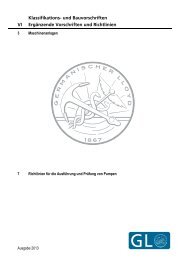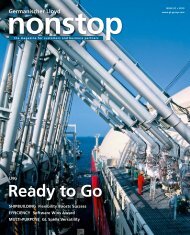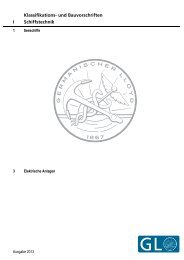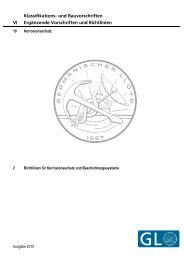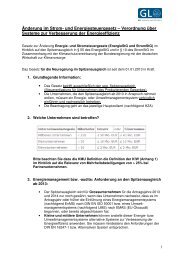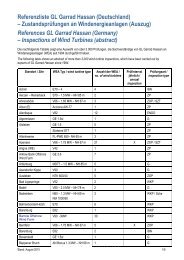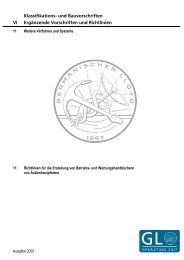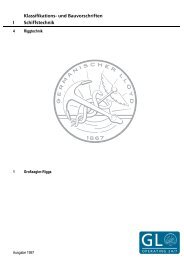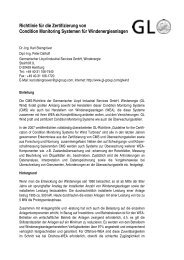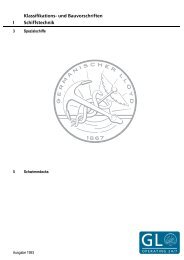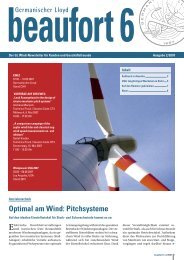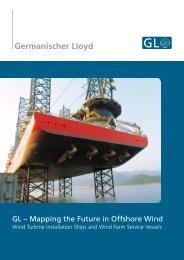Protection of Fuel Tanks Safety ahead! - GL Group
Protection of Fuel Tanks Safety ahead! - GL Group
Protection of Fuel Tanks Safety ahead! - GL Group
Create successful ePaper yourself
Turn your PDF publications into a flip-book with our unique Google optimized e-Paper software.
ed to gather more experience in agency business. In 1963<br />
he returned to London, and two years later he took over<br />
from Hans Schenkel as Managing Director. In 1967 he also<br />
became the majority partner.<br />
The late 1960s and early 1970s were characterized by<br />
continual service optimization. Instead <strong>of</strong> volume-based<br />
chartering, for example, the company began to charter<br />
ships for specific periods (time charter). This, in turn, required<br />
an adequate orders situation for the ships’ capacity<br />
to be utilized. In this way, Union Transport developed into<br />
more <strong>of</strong> a shipping company.<br />
From Charterer to Owner<br />
In 1973, the company bought its first vessel. It chose the<br />
German coastal vessel Claus Jürgens: twelve years old, <strong>GL</strong>classed<br />
and at a price <strong>of</strong> 50,000 pounds. Its new name was<br />
“Union Star”. The superfluous superstructure was removed,<br />
and the mast and funnel were fitted with a tilt mechanism<br />
so that the ship could pass under bridges when negotiating<br />
rivers. In contrast to purely coastal vessels, the “Union<br />
Star” was also seaworthy – enabling the company to <strong>of</strong>fer a<br />
service that its competitors could not provide: shipments<br />
from European inland ports to the UK without any timeconsuming<br />
stops along the way in Rotterdam or Antwerp.<br />
Union Transport’s customers appreciated this competitive<br />
advantage and the company’s proverbial reliability. In 1974<br />
it added the “Union Sun”, “Union Moon” and “Union Venus”<br />
to its fleet. Just three years later, Union Transport was able<br />
to deploy its first newbuildings. The “Union Gem” transported<br />
a thousand tons <strong>of</strong> sugar on its maiden voyage from<br />
London to Basel – a quantity previously unthinkable.<br />
The ships became bigger – making the question as to<br />
whether the logistics services could still be performed efficiently<br />
more pressing. The hydraulically-powered lifting<br />
and lowering system for the wheelhouse had not yet been<br />
invented. So the company simply removed the wheelhouse<br />
ro<strong>of</strong> to enable continued sailings to European inland ports.<br />
In view <strong>of</strong> fluctuating water levels, this structural alteration<br />
made it possible to extend the operating period <strong>of</strong> the Union<br />
Transport fleet.<br />
Apart from transporting cargo in bulk at sea, Union<br />
Transport established itself as a reliable carrier for the<br />
international oil industry and in the transportation <strong>of</strong><br />
heavy goods. For more than fifteen years it transported<br />
machines and equipment for McDermott, an oil company<br />
based in New Orleans. One <strong>of</strong> it biggest projects was<br />
to handle the logistics for setting up the oil fields in the<br />
Persian Gulf. Pipeline parts and cement were shipped<br />
from Japan to the Middle East in consignments <strong>of</strong> up to<br />
30,000 tons. McDermott, and therefore also Union Transport,<br />
were likewise involved in equipping the oil fields<br />
TRADITION.<br />
Loading<br />
and discharging<br />
port indicators<br />
for the<br />
deployment<br />
chart.<br />
UNION TRANSPORT | MARITIME SERVICES<br />
BRITISH COMMITTEE<br />
“I am a busy man”<br />
Not all the customers came into contact with<br />
Germanischer Lloyd while they were still at school.<br />
During a class trip, young Max Heinimann from<br />
Switzerland noticed that most <strong>of</strong> the inland vessels<br />
in the port <strong>of</strong> Basel were classifi ed by <strong>GL</strong>. This<br />
must have been signifi cant. Later, as an aspiring<br />
shipbroker, he implicitly trusted Germanischer<br />
Lloyd’s technical pr<strong>of</strong>essionalism. Most <strong>of</strong> Union<br />
Transport’s chartered ships were German coastal<br />
vessels with German owners and German crews.<br />
And they were all classifi ed by Germanischer Lloyd.<br />
The vessels chartered on a time charter basis, too,<br />
were all classifi ed by <strong>GL</strong>.<br />
The mixture. In 1986 Heinimann was asked by<br />
the <strong>GL</strong> board member Helm whether he wanted<br />
to become a member <strong>of</strong> the British Committee. “I<br />
am a busy man,” was the reply. Helm had to do a<br />
lot <strong>of</strong> convincing to tempt him to take part in the<br />
annual committee meetings and specialist lectures<br />
and debates. It’s the committee’s composition that<br />
makes it interesting, says Heinimann: “The mixture<br />
<strong>of</strong> shipowners, shipbrokers, insurance agents,<br />
shipyard directors and representatives <strong>of</strong> banks<br />
and investment companies, as well as representatives<br />
<strong>of</strong> the fl ag states and other maritime institutions,<br />
mean that you’re bound to learn something<br />
new at every committee meeting.” Max Heinimann<br />
was formally admitted at the annual meeting <strong>of</strong> the<br />
British Committee on July 18, 1986 and has been an<br />
active member ever since.<br />
The development. Ten years later, he was<br />
asked to take over as the chairman <strong>of</strong> the committee.<br />
How does Max Heinimann see the development<br />
<strong>of</strong> his classifi cation institution? “Over the<br />
past few years, Germanischer Lloyd has increased<br />
its activities and become more market-oriented.<br />
Today we talk ‘business’. We <strong>of</strong>fer a wider range<br />
<strong>of</strong> services, customer wishes are put into practice<br />
more quickly, and our readiness to innovate is<br />
impressive. The important things are still reliability<br />
and quality!”<br />
nonstop 4/2006<br />
27





